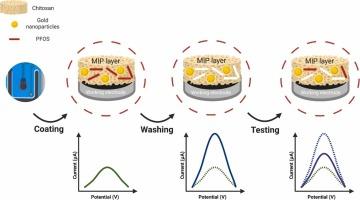Eco-friendly molecularly imprinted sensor interface using chitosan-gold nanoparticle composite for sensitive and selective trace-level detection of PFOS
IF 3.7
1区 化学
Q1 CHEMISTRY, ANALYTICAL
引用次数: 0
Abstract
A composite layer of chitosan–gold nanoparticles (chitosan-AuNPs) was developed as a molecularly imprinted sensor interface for ultrasensitive and selective detection of perfluorooctane sulfonate (PFOS). While preserving known advantages of biodegradable, eco-friendly characteristics of biopolymer, technical challenges associated with the limited charge transfer and shape deformation in aquatic environments that impede the advancement of molecular imprinted chitosan-based PFOS sensors were addressed by this work. Incorporating AuNPs with an optimized cross-linking strategy overcame the inherent limitations of chitosan, including poor charge transfer and instability of imprinted cavities in aqueous media, thereby enhancing electrochemical performance and imprinting quality. The resulting sensor, fabricated on a screen-printed carbon electrode, achieved a detection limit of 1.07 ppt, which is well below the United States Environmental Protection Agency (EPA) guideline of 4 ppt for PFOS in drinking water. It exhibited strong affinity and selectivity toward PFOS, effectively discriminating it from structurally related PFAS and common ions. The adsorption behavior followed the Langmuir isotherm, indicating homogeneously distributed binding sites with strong binding affinity. Importantly, the sensor demonstrated excellent recovery and reproducibility in real water samples, confirming its practical applicability. These results underscore the efficacy and practical applicability of the eco-friendly chitosan-AuNP MIP sensing platform for the detection and monitoring of PFOS contamination in aquatic environments.

利用壳聚糖-金纳米颗粒复合材料的生态友好型分子印迹传感器界面对痕量全氟辛烷磺酸进行敏感和选择性检测
开发了一种壳聚糖-金纳米颗粒复合层(壳聚糖- aunps)作为分子印迹传感器界面,用于超灵敏和选择性检测全氟辛烷磺酸(PFOS)。在保留生物聚合物可生物降解和生态友好特性的已知优势的同时,本研究解决了与水生环境中有限的电荷转移和形状变形相关的技术挑战,这些挑战阻碍了基于分子印迹壳聚糖的全氟辛烷磺酸传感器的发展。将aunp与优化的交联策略结合,克服了壳聚糖在水介质中电荷转移差和印迹腔不稳定等固有的局限性,从而提高了电化学性能和印迹质量。由此产生的传感器在丝网印刷的碳电极上制造,其检测极限为1.07 ppt,远低于美国环境保护署(EPA)饮用水中全氟辛烷磺酸4 ppt的准则。它对全氟辛烷磺酸具有较强的亲和力和选择性,能有效地将其与结构相关的全氟辛烷磺酸和普通离子区分开来。吸附行为遵循Langmuir等温线,表明结合位点分布均匀,结合亲和力强。重要的是,该传感器在实际水样中表现出良好的回收率和再现性,证实了其实用性。这些结果强调了生态壳聚糖- aunp MIP传感平台在水生环境中全氟辛烷磺酸污染检测和监测中的有效性和实用性。
本文章由计算机程序翻译,如有差异,请以英文原文为准。
求助全文
约1分钟内获得全文
求助全文
来源期刊

Sensors and Actuators B: Chemical
工程技术-电化学
CiteScore
14.60
自引率
11.90%
发文量
1776
审稿时长
3.2 months
期刊介绍:
Sensors & Actuators, B: Chemical is an international journal focused on the research and development of chemical transducers. It covers chemical sensors and biosensors, chemical actuators, and analytical microsystems. The journal is interdisciplinary, aiming to publish original works showcasing substantial advancements beyond the current state of the art in these fields, with practical applicability to solving meaningful analytical problems. Review articles are accepted by invitation from an Editor of the journal.
 求助内容:
求助内容: 应助结果提醒方式:
应助结果提醒方式:


